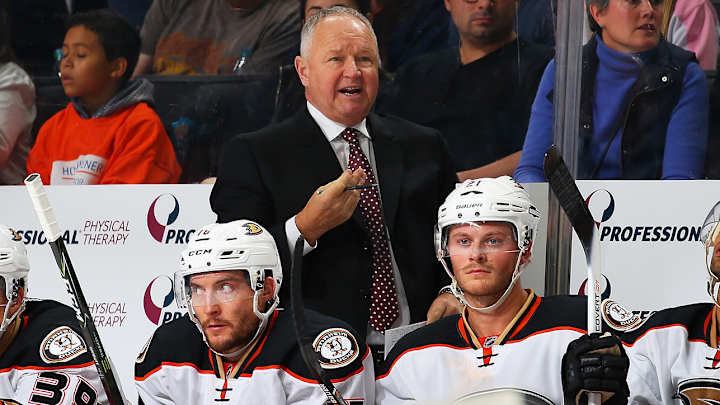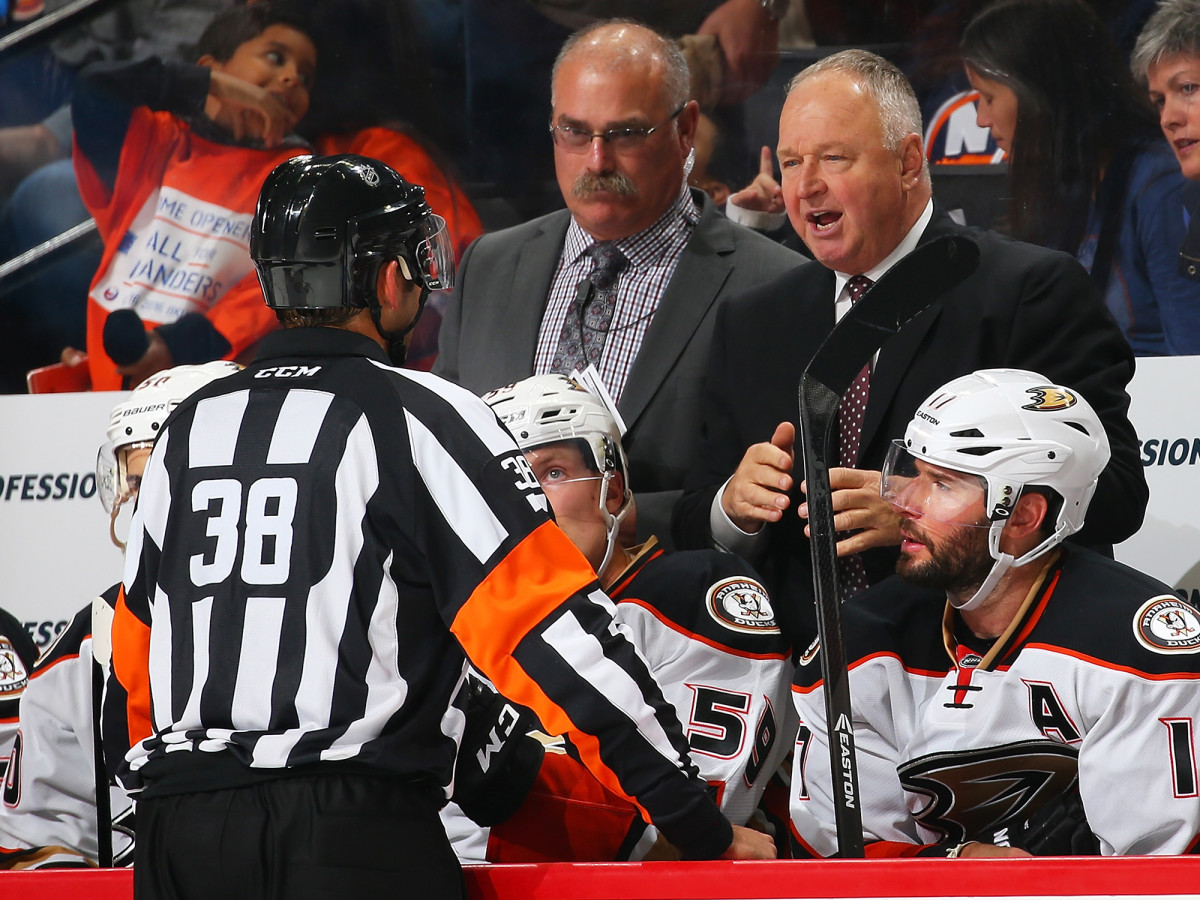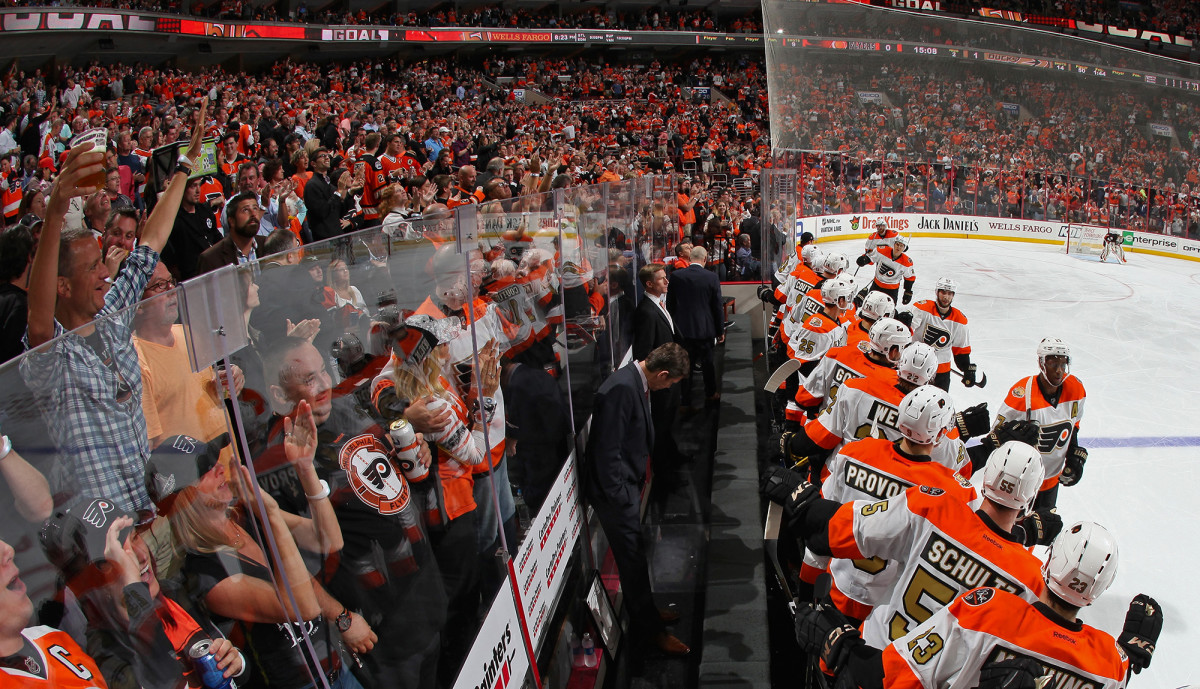Back in Anaheim: Ducks coach Randy Carlyle on his unusual return, team outings, more

PHILADELPHIA – Randy Carlyle wore a slight smile when he walked from the visiting coaches’ room at Wells Fargo Center, carrying an iPad and a 3-2 victory, his first with the Anaheim Ducks this time around. After three regulation losses, one overtime defeat, and eight minor penalties committed Thursday night against Philadelphia—including three trippings in nine minutes deserving of their own sad trombone soundtrack—the positive vibes were well earned. “Hey, when you’re on the road, you’ve got to find points, got to find ways to win,” Carlyle said. “It’s about time we won a hockey game, that’s for sure.”
It had been 1,786 days since Carlyle’s last triumph behind the Ducks’ bench, 4-1 over Montreal on Nov. 30, 2011, after which he was promptly fired by GM Bob Murray. Time passed. The Ducks thrived under Bruce Boudreau, Carlyle’s immediate replacement, nabbing four straight division titles and reaching 100 points in each of his three full seasons. Carlyle, meanwhile, helmed Toronto for 188 games before exiting midyear in 2014-15, then spent last season watching unaffiliated in the southern California area.
Now he is back, hired anew June 14 by Murray, who had dismissed Boudreau when the Ducks fizzled in last spring’s first round. Wednesday afternoon, after an hour leading Anaheim through practice in Philadelphia, nearing the end of their season-opening road trip, Carlyle spent 10 minutes with SI.com talking about his year away from coaching, his unlikely and unusual return to the Ducks, paintball and nickel mining.
Alex Prewitt:At your introductory press conference in June, the first thing you did was pull a piece of paper from your jacket pocket and begin thanking people in the Ducks’ organization. What were you feeling at that moment?
Randy Carlyle: I just felt very fortunate to be back. Transitioning back into the Anaheim Ducks organization was pretty seamless. I still know most of the people, unfortunately the PR department’s still a pain in the ass—oh, is Steve here? That’s what makes it easier and just fortunate. I think, though our record doesn’t indicate it, we have more of a team than what we’ve displayed early here. I watch the team play. We’re transitioning some younger players into the lineup. We’re missing some key personnel now, but I think there’s a lot more for this team to grow into.

AP: When you were in the press box last year, watching Ducks games at Honda Center or San Diego Gulls games in the AHL, how did you keep track of what you saw? What was your process for taking notes?
RC: I have a template that I try to fill in on scouting—what I think is important in the game, what teams are doing, how they’re defending, how they’re transitioning the puck, how the updated NHL is performing. That’s what I go to the game for. I try to take that knowledge or steal whatever’s going on the ice at that moment, and I try to make sure I’m up to speed in what teams are doing.
I think there’s pretty much a template. Most of the teams play the same way. Everybody has a version of the defensive zone coverage, everyone has a version of moving the puck through the neutral ice, to the middle from the defensive zone. The penalty killing is very similar. There’s not a lot of drastic change. Sure there are a couple different neutral-ice traps, or the 1-3-1, but basically there’s a template that the whole league is playing to, and you’ve just got to execute to a higher level and make less mistakes than the opposition.
AP: There are stories of you planning off-day outings for your teams, like bumper cars or bike rides, even at a sports bar before Game 7 against Calgary in 2006 during your first season with Anaheim. What do you get out of those?
RC: What it does, it brings everybody to the same level. It brings a lot of the true person out in the individual that teammates would never see. You bring them into those environments, and everyone starts at ground zero. Everybody’s the same. We’ve done shooting, we’ve done go-kart racing, we’ve done paintball, bike rides, fishing excursions for the day. Coming off those things, I’ve found it can never hurt your team. It can only help. It might not be looked upon as much of a bonding experiment, but it’s a fun day together outside the game. And what the players like about it, they don’t have to practice. It takes the place of practice.
Capitals mild-mannered defensemen Alzner, Niskanen are a duo on and off the ice
AP:Do you have a favorite?
RC: Riding the bike through Stanley Park in Vancouver was a neat one. We played outdoor hockey on a canal in Ottawa, on the frozen canal during my early years with the Ducks. Usually you feel good about it because it was a fun day. We’ve had pool tournaments, gone to the shooting range, done numerous things. The one that players I’ve seen get most involved in is the paintball, because they gang up on the coach. You’ve got all the garb on. In reality, they want to shoot the coach.
AP: Anything planned for this year?
RC: The hectic schedule we’ve been presented makes that a challenge, but we will do something. I’ve got a few things that we haven’t done before that I think would be fun, and I think this group needs that. When we’re on the road as much as we are, I jut think we’re together all that much but it’s not in the same environment. It’s not 23 guys. It’s five guys going to dinner, five guys going here, where if you do something that’s totally outside of what they normally do, you seem to find a lot of smiles on their faces. It’s just a kick-back day.
AP: Why do you say this group needs that?
RC: We’re five in a row on the road. It’s a tough start to the season. But that’s our responsibility, that’s the schedule we’re presented. Other teams are going to have challenges with their schedules.
AP: Getting into your background a little bit, you grew up near Sudbury, Ontario, nickel mining country. What did you learn from two summers working the overnight shift there?

RC: That I didn’t want to do it the rest of my life. It was a mining town, a mining refinery, so I worked at the FBR building, which is a fluid bed roaster. So when the ore body is mined and they bring the ore into liquid, these roasters take the moisture out it, so it becomes nickel in a fine ground-up form, like a coarser salt.
They’d hand you a five-gallon can of paint and go paint everything that’s gray. So anything gray in the hallway, you had to steam-clean and paint, so you were painting with a five-gallon pail. Then I got to paint all the fire extinguishers and the boxes for emergencies. They had a certain red box that had to be painted around it, so people could find it.
It was industrial work that paid well comparatively. I was making a labor rate of over $10 an hour, working 40 hours a week, so $400 a week was good money, versus when you were working on the softball fields, cutting grass at the community centers, stuff like that, making $2.75 to $3 an hour, and all of a sudden you’re making $10 an hour. That felt like a lot of money.
It’s not that hard. To me, that’s just what people do. When you see that kind of a workforce, and you’ve got family members doing it on a day-to-day basis and it’s a premium-paying job in a small community or a small town, then you learn to appreciate it. There was a strong union. You had full benefits, full medical, full dental, full vision. The package that went to your families were great.
Las Vegas owner Bill Foley is confident his new NHL team name is worth the wait
AP: When did you realize that you weren’t going to be working there your whole life, that you could use this hockey thing as a way out?
RC: When they asked me if I wanted to stay, they asked me if when I was finished with grade 12, they had an opportunity if I felt like staying, I could continue to work. I was a part-time student, a summer student. I decided then that I wasn’t going to work in the mine or in the industrial side of life. I was fortunate. That’s not to say I had any grandioso plans, other than that wasn’t what I was going to do. I was going to play hockey or I was going to go to school. I wasn’t a great student by any means.
AP: How did you get the nickname Kitty?
RC: Ian Turnbull named me that in my first year [with Toronto in 1976-77], because I was a kid in their eyes. I was a 20-year-old defenseman. Plus, Kitty Carlisle on “To Tell the Truth.” That was Ian Turnbull. It just kind of stuck. I was a kid, and Kitty Carlisle. That was the name that stuck. That’s all.
